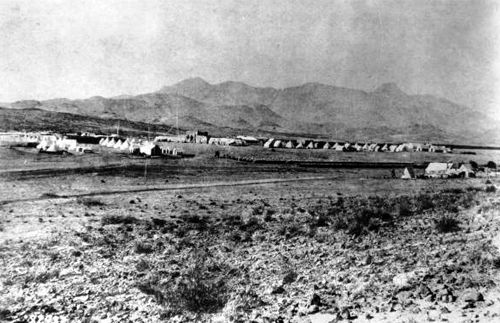Fort Cummings
January 21, 2022
Our obsession with the historic area near Cooke's Peak continues unabated. With the bathroom rehab project finally behind us, we took a day off to explore the former site of Fort Cummings at Cooke's Spring.
The area at the southern base of Cooke's Peak has been occupied for millennia. Following, or perhaps concurrent with, the evacuation or extermination of the Mimbres people, Apaches moved into the area and established small semi-permanent rancherias. The end of the Mexican-American War in 1848 resulted an influx of Anglo settlers and miners into the newly conquered territory. They made their way west via a traditional trail through Cooke's Canyon, where a spring provided a reliable source of water for travelers and their livestock.
In 1857, James Birch established mail and passenger service between San Antonio and San Diego, following the trail through Cooke's Canyon. John Butterfield followed suit the next year, connecting eastern termini in Memphis and St. Louis with San Francisco with what became known as the Butterfield Trail.
Ruins of the stage station at Cooke's Spring. Coaches from both services stopped at a newly built stone way station at Cooke's Spring, where an onsite crew changed out draft teams and fed drivers and passengers.
Not surprisingly, the Apaches and their chief Mangas Coloradas saw these incursions as a threat to their homeland. The stage lines terminated service during the Civil War, and the Apaches determined to drive the remaining settlers from the area. During the ensuing conflict their forces are reputed to have killed more than 400 travelers.

Fort Cummings in 1882. Cooke's Canyon became known as the most treacherous section of the westward trail, and despite the ongoing Civil War, the Lincoln Administration established a new post at the eastern end of Cooke's Canyon near the spring and the now vacated stagecoach station. Construction began in 1863.
Site of Fort Cummings today.
Little remains of the 10-foot high adobe wall that enclosed a parade ground and various buildings including barracks, a hospital and officers' quarters. By the early 1870s, US forces had largely suppressed the Apache threat and soldiers began to withdraw, abandoning Fort Cummings in 1873. The Army reoccupied the fort briefly from 1880 to 1886, in response to a new campaign by the Apaches, now under the leadership of Chief Victorio.
A cemetery was established on a nearby hill after stage passengers complained that numerous skeletons were visible from the road. Soldiers were detailed to collect the remains which were probably buried in a common grave. The surrounding wall was erected in 1867 by Black soldiers of the 38th Infantry (Buffalo Soldiers). The wall-building project may have punishment for alleged mutiny by several of the enlisted men. The only headstone in the cemetery, placed at a later date, records the death of four privates from Company G of the 1st Veteran Infantry of the California Volunteers who were killed by Apaches in 1866 while on a woodcutting detail a few miles from the fort.
The stage station was rendered obsolete with the completion of the Atchison, Topeka and Santa Fe Railroad to Deming in 1881. To supply water for its steam engines, the railroad stuck a deal with the Federal Government in 1882. AT & SF would clean the spring and cover it in exchange for half the water (estimated at 50,000 gallons per day). The water was piped to the nearest tracks at Florida Station.
Detail of the spring house roof.
The roof was reconstructed in 1987.
Spring house interior.
1912 graffiti.
Pavers that we speculate might have been used as fill for a low spot on the Butterfield Trail. After exploring the site of Fort Cummings, we tried to find a way around the Hyatt Ranch inholding north to Cooke's Town. But past the trail to Cooke's Peak, the rough road becomes tiresome. On another day we may continue on foot or mountain bikes. I'm not sure why I need to make my way to Cooke's Town, since from all reports there's little left of the former mining boomtown. But go I must, having read James McKenna's "Black Range Tales" and his accounts of serving as justice of the peace in what he describes as "one of the most barren spots upon the face of the earth".
Its formation is mostly a dolomite limestone cut with porphyry dikes. For miles there is not enough earth to bury a cat."
Sources:
- Interpretative signage at Fort Cummings.
- "Below Cooke's Peak: Prehistoric Sites and More", by Jay W. Sharp.
- "Cooke's Peak – Pasaron Por Aqui: A Focus on United States History in the Southwestern New Mexico", by Donald Howard Couchman.